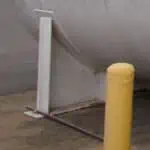

When it comes to running your facility, there are many things you are constantly considering and managing. The list can seem never-ending, from worker safety to product supply chain and staying staffed. The last thing you want is a surprise visit from your local, state, or federal regulator that goes badly. Here are five things to look for to avoid unpleasant surprises to ensure your aboveground storage tanks (ASTs) are inspection-ready.
Make sure that your AST secondary containment is empty. The secondary containment design is to prevent spills and leaks from reaching the environment, so the containment should be emptied after each rain, once the contents are verified to be only stormwater and free of sheen. Also, regular cleaning of the secondary containment of algae and debris build-up avoids potential issues during inspections.
A locked containment drain valve is essential to demonstrate compliance with your visiting regulator. The locked valve will prevent any unauthorized connections, which can lead to potential environmental hazards. For instance, during my time at the Arkansas Department of Environmental Quality, a facility was fined because an untrained maintenance technician had drained an overflowing paint tank to a nearby stream via a garden hose connected to the secondary containment valve. By locking your containment drain valve, you mitigate risks and show your commitment to environmental safety.
Ensure you update staff on spill response training. Proper training is key to handling spills efficiently and safely. By providing your employees with the necessary knowledge and skills, you can create a proactive culture of environmental responsibility within your organization.
Have a fully stocked spill kit next to your tank and other likely spill points. Accidents happen, and it is crucial to be prepared with the proper supplies for potential spills. Having a spill kit ready and available can help you respond quickly and effectively, minimizing any environmental impact. Your SPCC Plan should include a list of spill kit locations, the contents of each spill kit, and a schedule for inspection of these kits. Following your SPCC Plan’s inspection schedule and forms will help you check and replenish the spill kit to ensure they are always ready for you when needed.
Check that your AST safety features are in good working order. Your tanks should have functioning fill gauges and alarms. These devices are essential for monitoring the contents’ level and preventing overfilling, which can lead to spills and other hazardous situations. Another crucial aspect to consider is the functioning of the emergency vent. Common issues with emergency vents include manway bolts that are secured too tightly without any slack, painted-over vents, or busted heat latches that can allow water to enter.
Regularly inspect and maintain all of these to ensure their proper functioning – they play vital roles in preventing spills and other potential tank failures. Remember to keep a copy of all your inspection forms to show your visiting regulator – it gives agencies confidence in your ability to protect the environment.
______________________
Being prepared for tank inspections is essential for any facility managing ASTs. Following the recommendations above demonstrates your commitment to worker and community safety, product supply chain integrity, and environmental responsibility.
Additional Resources:

About the Author: Benjamin Reynolds is a Senior Project Professional in our Little Rock, Arkansas, office. He is experienced in Spill Prevention, Control, and Countermeasures (SPCC) Plans, Tank Assessments, Storm Water Pollution Prevention Plans (SWPPPs), and Phase I and Phase II Environmental Site Assessments. He is a Professional Engineer licensed in Arkansas, Oklahoma, Tennessee, and Florida.
Reach out to Ben at or on LinkedIn.
Unexpectedly replacing a tank can strain your budget and always seems to come at the most inopportune times. Based on my experience with tank inspections, one of the most common reasons for unexpected tank replacements is using an Underground Storage Tank (UST) as an Aboveground Storage Tank (AST).
Any STI/SPFA SP001 Certified Inspector can identify a misused UST during the required periodic inspections of ASTs, and these tanks are also commonly discovered during site visits related to drafting or updating Spill Prevention, Control, and Countermeasure (SPCC) Plans. Budget and complete a tank replacement before your next inspection. During my inspections, I use three indicators when looking at a tank to identify if a UST is misused as an AST:
No Emergency Vent! The most important reason not to use a UST aboveground.
If the unthinkable happens and you have a fire around your tank without proper emergency venting, that tank fire can go from bad to BOOM!
The design of ASTs is to minimize the danger of being engulfed in flames to release the vapors from the tank in a controlled manner. In contrast, a UST design will never be engulfed in flames, so the tank manufacturer does not install an emergency vent port.
Properly sizing an AST emergency vent to release the increased vapor pressure during a fire is important, too. The need to release the higher pressure makes emergency vents much larger than the normal vents for simple atmospheric changes. The larger emergency vents come in five varieties:
Flip-up vents are spring-loaded caps held closed by a latch designed to release at a set pressure or temperature. If the latch doesn’t work and the flip-up cap is open, duct tape or a well-placed brick is not the proper solution; you’ll need to replace the latch. Luckily, the latches are readily available, and the latch installation is usually simple.
Rupture disks are vent covers where the entire cover breaks open when a set pressure or temperature is exceeded, instead of just the latch like in the flip-up vents.
Pop-up vents are weighted caps that sit on the vent until the pressure in the tank reaches the designed level. During fire incidents, these vents periodically release the built-up vapors, preventing the tank from rupturing. If this vent is not staying seated correctly, repair or replace the vent.
Long bolt manholes function similarly to the pop-up vents to periodically release built-up vapors. This type of vent relies on the bolts securing the manhole cover to have the designed amount of slack between the manhole rim and the nuts. I’ve seen too many long bolt manholes with the nuts fully tightened to the rim, completely negating the vent’s purpose and safety. A simple fix for this issue is to replace the fully threaded bolts with properly sized partially threaded bolts.
New tanks are unlikely to have Weak Roof-to-Shell joints. Occasionally, I’ve seen them in older single-wall vertical tanks, where the roof construction has a particular area break when the tank pressure gets too high.
Unreviewed Damage: Most USTs as ASTs are old and damaged
Frequently pulling these tanks results in dents or scraps to the UST. Remove any damaged tanks from service until a qualified inspector or engineer can review the damage. Additionally, most states prohibit the reuse of USTs once they are removed from their original installation location.
It may be difficult to see in this image, but the tank is scratched, dented, and starting to rust.

Most of the repurposed USTs are horizontal, so these tanks require chocks or an earthen berm to keep them in place. Saddles act as the welded attachment areas for the tank legs and distribute the weight over the tank’s belly — part of the AST design. Sometimes, people with good intentions get too creative and attempt to turn a UST into a vertical AST. However, the presence of vent connections along the side of the tank and none on the tank top is a sure sign the tank is not in use appropriately.
Best practice — look for these warning signs before inspections and drafting or updating SPCC Plans.
